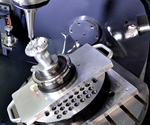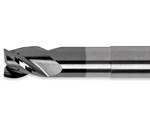Tips for Mitigating Chatter and Vibration
A review of the problems of machine vibration and the strategies and tooling systems that that can stop them.
Vibration can be a common problem faced by shops. A resonance frequency issue, vibration happens as a tool is trying to move out of its designed path or center. As it does, the tool starts to deflect, which causes chatter. This can have an adverse impact on machining: tool life is negatively affected, spindle bearings take up vibration which affects their life, lost productivity from slowing the process down, and out-of-tolerance workpieces.
There are a few ways to combat vibration. One is to identify tool deflection as the root cause of the problem. This can take several forms, from cantilever deflection to holding being done with a pulling element. Since deflection is based on the amount of force, the higher the force, the greater the deflection.
There are a few ways to combat vibration.
Better programming reduces such forces, leading to a smoothly run operation. Better tool selection, sharper cutting edges, reducing length and applying five-axis technologies all can be beneficial in the anti-vibration fight. But keep in mind that three important forces play a role on tools—radial, axial and tangential.
As for starting points, programmers should consider the length to diameter ratio. Anything 4:1 and less, the manufacturer’s recommendation is good to go. But for a ratio lower than 5:1, some changes are in order. Look at the insert radius and change to a sharper cutting edge. At a ratio of 6:1, chatter is very likely, and adjustments are necessary if over 7:1.
For small end mills, adjustment for chatter is still recommended. A few steps can be taken to reduce engagement. Reduce the number of flutes, use both a variable flute and helix end mill, which should break up the chattering. Reducing the depth of the cut can also help—focus on the axial and radial forces.
The biggest problem is when there is chatter in the shank. Cutter shank engagement in the tool holder should be at least 2 ½ x D. Using both the shortest tool holder possible and balanced tool holders, as well as minimizing runout are good options to reduce vibration.
Vibration reduction techniques extend into programming solutions. Among those is utilizing trochoidal milling programs, installing CAM software that maintains constant chip thickness, employing circular interpolation in corners with a smaller tool, and finding the tool assembly’s “sweet spot”—all leading to finding the machine’s natural frequency.
Ultimately, damping technologies offer the greatest possibility of eliminating vibration. Although not a new concept, damping can automatically identify the source of vibration and help with the frequency.
Related Content
-
Treatment and Disposal of Used Metalworking Fluids
With greater emphasis on fluid longevity and fluid recycling, it is important to remember that water-based metalworking fluids are “consumable” and have a finite life.
-
Modular Tooling Systems Enable Versatility in Hole-Drilling Operations
The versatility of replaceable cutting edges offers users the ability to adapt to varied operations.
-
How a Small Programming Change Cuts Cycle Time in Half
Overriding the CAM system when milling a series of lifter pockets helps to improve metal removal rate and increase feed rates.







.png;maxWidth=300;quality=90)







